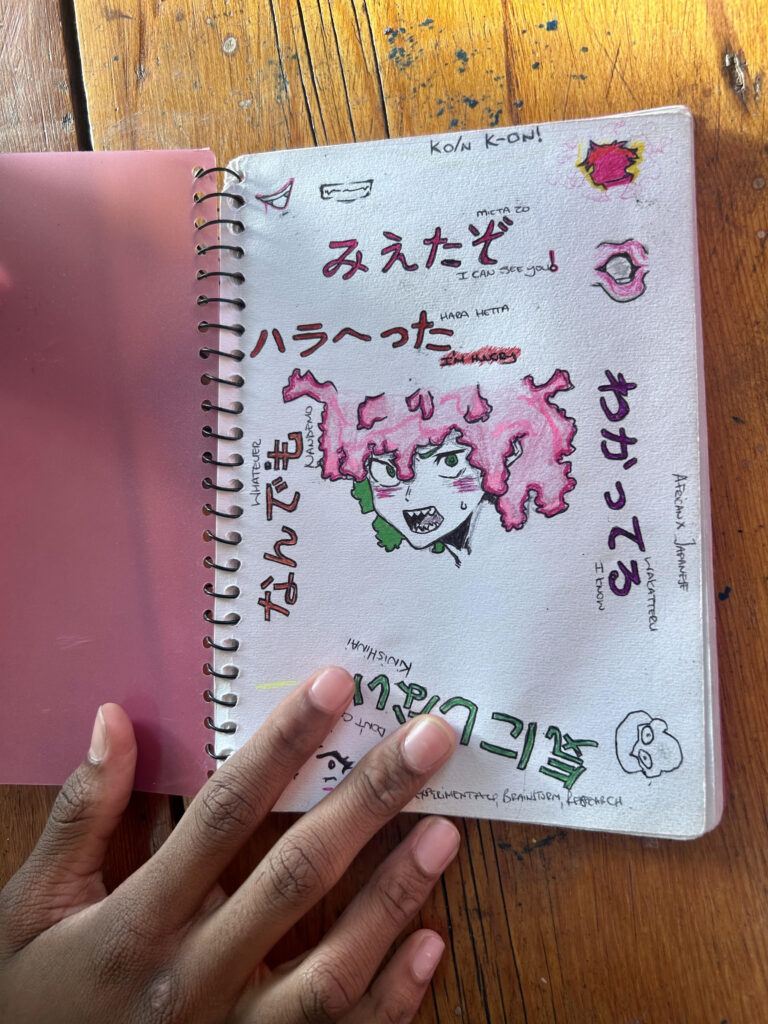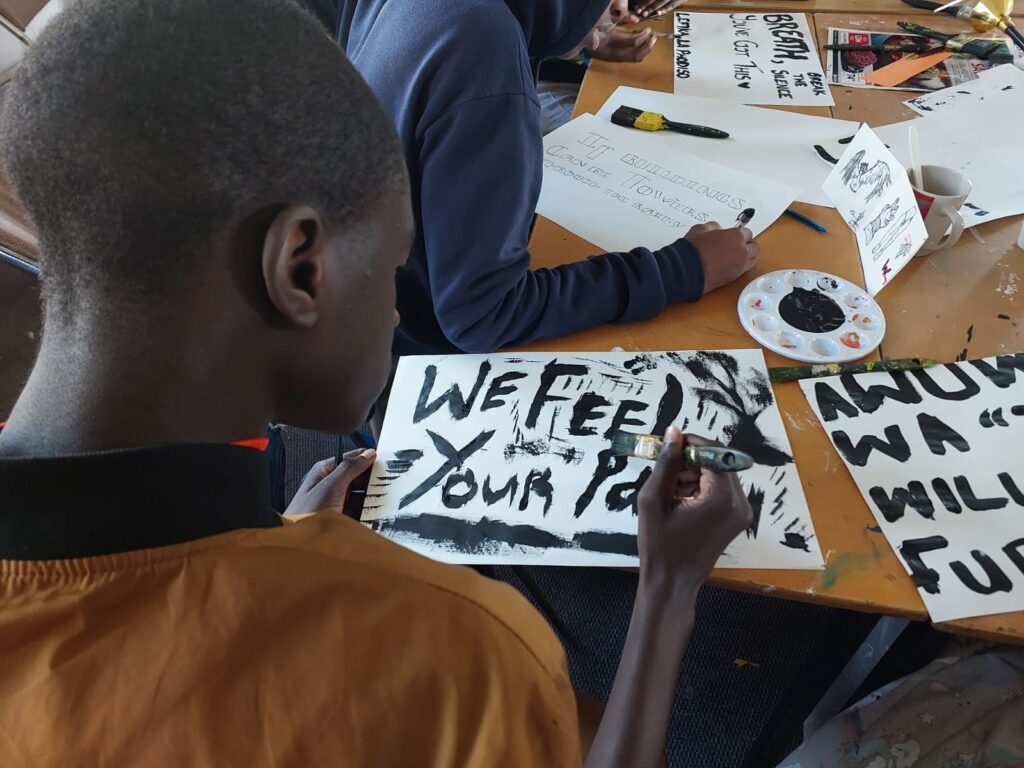- Connecting with friends and being part of group activities are good for teenagers’ mental health. But during COVID, not being able to go to school or see friends meant many adolescents lost that support.
- Research shows that up to 20% of children and teens will develop a mental health disorder or a problem with brain development. But only one in 10 will be able to get help.
- Mental health problems often start before the age of 18, and in many cases even by the time someone is 14 years old, which is why catching problems early — and putting things in place that can protect kids — is important for building resilience in the next generation.
Victor*, 15, and his friend Gabriel*, 14, are drawing anime-like characters, made popular by Japanese cartoons.
Millions of teen artists around the world have taken a liking to drawing these characters.
Victor’s character, named Hara Hetta, has pink hair that looks like an abstract world map and sharp teeth, like a werewolf.
His inked lines are jagged, and Hara Hetta’s gaze is serious, penetrating.
A bevy of other kids sit scattered among paint, paper, clay and other materials. Behind them, images of Johannesburg’s skyline, mosaiced with colourful magazine clippings, frame the room, and the abstract city looks like the container of their dreams.
A poster advertising a “first-aid workshop” for teen mental health is pinned on the notice board.
Victor signs his name in Japanese script next to his drawing with the words “African X Japanese”.
He’s one of the teens who suffered social isolation during the COVID pandemic and who has found help at Lefika La Phodiso, an after-school programme based at the Children’s Memorial Hospital in Johannesburg’s inner city, on the border between Braamfontein and Hillbrow.

The centre’s name means “rock of holding and healing” in Sesotho and is a place that helps children to thrive through art. For Victor it has been exactly what the name says for the past nine years.
“At first, I came for the food. I was this scared little boy. But [here] I met the amazing facilitators and counsellors [who spoke to me and got to know who I am].”
Victor lives with his family in Johannesburg’s densely populated inner city. When COVID hit, he stopped going to school. He didn’t attend for almost three years.
But since early 2023, he’s been at the National School of the Arts, thanks to Lefika helping him and his mom to fill out forms, talking to the school about getting the enrolment fee waived and helping with admin matters.
During the COVID-19 lockdowns in 2020 and 2021, when kids’ school routines were upset for months on end and he couldn’t see his friends, his mental health took a knock.
He explains: “I began noticing so many faults in myself. That I don’t have good looks, that maybe my art isn’t good or my hair isn’t nice. I felt alone.”
Why school is cool
During adolescence, our brains undergo a lot of change to help us make sense of social interactions. These changing and growing nerve paths in their brains make teenagers vulnerable to developing behaviour problems and mental health disorders, including depression, anxiety disorders, learning difficulties and substance abuse disorders.
COVID restrictions made things worse for many teenagers in South Africa who, because of situations such as household unemployment, difficult family dynamics and food insecurity, already face mental health stressors.
Research from the Children’s Institute at the University of Cape Town reveals that even with the best possible plans in place to promote mental health, 10–20% of children and teens will develop a mental health disorder or a problem with brain development.
But only one in 10 will be able to get help.
In fact, in 2020, fewer than half of the World Health Organisation’s member states had a mental health plan in place for adolescents, a report shows.
Moreover, studies show that people from poor households struggle to get help with mental health even more.
Getting help early is critical. In about half of adults with mental health disorders, it started before they were 18 years old, a large analysis shows, and in many even by around 14 years of age.
“A teenager’s brain is primed for social connections, particularly with peers,” explains Sahba Besharati, co-founder of the Wits Neuroscience Research Lab (Wits NeuRL). “The trouble is that we don’t know enough about what really goes on in the adolescent brain. But what we see is that the way external and internal events shape the brain during these years has enormous implications for adulthood.”
Rozanne Myburgh, Lefika’s managing director and registered arts therapist, has seen how the lack of social connections during COVID has affected children first hand — and how getting back to class can turn things around.
Many children who attend their programmes simply haven’t gone back to school since that first lockdown, she says, and it’s had “a devastating effect on their self-esteem and mental health“.
Says Myburgh: “When children get back into school, it’s like they become upright and [feel] brighter. It doesn’t even matter if the school isn’t that good. At least they get to do what teenagers are meant to do: make friends and socialise and have a vibrant youth.”
Can we hit “undo”?
The Asenze Cohort Study in KwaZulu-Natal has tracked almost 1 600 children since 2008 to understand how life circumstances affect their health, social wellbeing and brain development from childhood through adolescence.
In the fourth part of the study, which started in 2022, researchers also looked at how the COVID pandemic changed social factors that affect health, such as employment and access to schooling, and how this impacted teenagers.
Chris Desmond, one of the lead investigators in the Asenze Study explains that, so far, their data shows that COVID has revealed huge inequalities.
“Our study participants didn’t have laptops and couldn’t access Wifi to carry on with their schooling. We don’t know if those years of education can ever be caught up.”
The effects of the pandemic are cumulative, he says. With many caregivers having lost their jobs, children grow up in poorer families. Then there were the riots [in KwaZulu-Natal in July 2021], he says — and, in April 2022, devastating floods.

“What we see is that adolescents are not growing up in an environment that protects them. Adults also struggle with mental health, and often don’t have the emotional bandwidth to respond appropriately to the teenagers in their care.”
Since the start of the long-term study in 2008, several teens in the Asenze group have died by suicide.
Desmond notes: “It’s a spiral effect. The consequences of poor mental health in adolescence are a pathway to a difficult life.”
Staying connected
But children’s mental health is not taken seriously enough, experts warn.
Despite the department of health drawing up policy guidelines for child and adolescent mental health as part of primary healthcare in 2003, there are very few dedicated psychiatric centres for children and teens.
In fact, a statement from the Children’s Institute says there are only 15 psychiatrists in public hospitals who work specifically with children and adolescents — yet children and teens younger than 18 make up about a third of South Africa’s total population.
Mark Tomlinson, one of the Child Gauge report’s authors and co-director of the Institute for Life Course Health Research at Stellenbosch University, says that COVID revealed how poorly society treats children and adolescents.
“Not one government in the world asked kids how they felt about school closures and lockdowns. We threw kids under the train,” he says.
“Teens have incredible insights, yet their voices are absent in public life. If we took a moment to ask kids what they actually want, instead of handing them top-down interventions, we’d come a long way in addressing mental health challenges.”
According to Tomlinson, teenagers need to be equipped with the tools to manage mental distress, which is a normal part of life. These can be things like spending time with friends, playing team sports and having a caring support system.
“Young people should also have ample opportunities for meaningful connection and growth,” notes Tomlinson.
Kylah Sim, a student counsellor who co-runs the “Volunteens” programme at Lefika has seen how being part of a project can help teens build resilience. “We noticed that the learners attending the after-school activities love to help by cleaning the activity rooms. We started running workshops to prepare them for volunteering at our holiday programmes and so build important life skills.”
For example, those wanting to be part of the programme had to “apply” and so learnt interviewing techniques and how to communicate well. “They put together a proposal for a ‘connection event’ with the staff, which they came up with all by themselves,” says Myburgh.
“Their confidence has grown so much.”
* In line with reporting on children guidelines, surnames are not divulged.
Beth Amato is a wordsmith living in Johannesburg.




